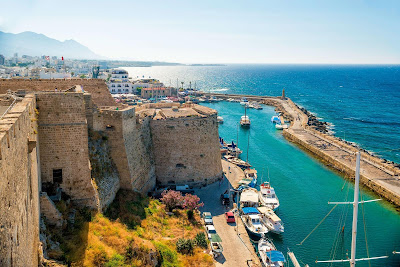People lived near the harbor of Kyrenia from time immemorial. It is very convenient for the port. That is why, near the bay, a place was chosen for the construction of a defense structure. When the power of the kings from the Lusignan dynasty was established on the island, construction work began, significantly strengthening the walls of the previously built fortress, which is gaining a reputation as “impregnable”. Here notable prisoners were kept under arrest. For example, knights of the once powerful Order of the Templars were executed. During the invasions of the island, the royal family was often sheltered in the fortress and the state treasury was kept. The fortress withstood a long siege.
For almost four years, Queen Charlotte, besieged by
the army of her illegitimate brother James, lasted in her during the war for
power in Cyprus in the first third of the 15th century. James tried to take
Kyrenia by storm, hoping to starve his sister from the island. When the cook
began to feed Queen Charlotte with omelet from passerine eggs, she fled to
Rhodes, and the starving garrison capitulated.
During the reign of the Republic of Venice in Cyprus,
the new rulers greatly strengthened the fortress, placing powerful artillery in
it. These works were carried out under the supervision of the Venetian
architect Savorniani. The defense of Cyprus was built by Venetian military
experts on the "three whales" - the fortresses of Kyrenia, Nicosia
and Famagusta. During the Venetian-Turkish war of 1570-1573. The fortress was
handed over by the commandant of its garrison, Gian-Mario Murazo, to the
commander-in-chief of the forces, Mustafa Pasha, without a single shot on
honorable conditions.
The Venetian Senate found out about this and sentenced
Gian-Mario Murazo to life imprisonment. As a result of the surrender of the
fortress, it is well preserved to our time and represents an excellent example
of the fortification art of the medieval period.
The main attraction of Girne is still the old Kyrenia
fortress. It has survived to the present day almost the same as it was in the
Venetian period, with the exception of internal buildings.
Passing through the gates of the fortress along a beautiful stone bridge (once lifting) and a long gallery, which was modernized by the Venetians, you can go inside. The Venetians have built into the walls of the Byzantine chapel of St. George. Above the entrance to the inner gates of the fortress, one can see the heraldic signs of the kings of medieval Cyprus from the Lusignan dynasty - the rooted lion and the "five-cross" (Jerusalem Cross).
The gallery contains the grave of the Turkish admiral
Algerian Sadiq Pasha, who died in Girne from wounds received during the assault
on Famagusta. You can climb the stairs to the very top of the old powerful
tower of the times of King Henry (1208-1211). Along the wall you can go to a
new tower of Venetian buildings, where the main artillery positions of the
fortress were located. The defenders of the three old towers relied on the
catapult and boiling tar, which they poured onto the heads of the assault. In
total, the fortress could accommodate about 50 large-caliber guns. The old
cast-iron cannonballs and stone catapult cores still lie in the courtyard of
the fortress.




No comments:
Post a Comment